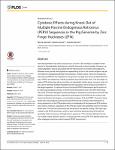Cytotoxic Effects during Knock Out of Multiple Porcine Endogenous Retrovirus (PERV) Sequences in the Pig Genome by Zinc Finger Nucleases (ZFN)
Semaan, Marwan
Ivanusic, Daniel
Denner, Joachim
Xenotransplantation has been proposed as a solution to the shortage of suitable human donors for transplantation and pigs are currently favoured as donor animals. However, xenotransplantation may be associated with the transmission of zoonotic microorganisms. Whereas most porcine microorganisms representing a risk for the human recipient may be eliminated by designated pathogen free breeding, multiple copies of porcine endogenous retroviruses (PERVs) are integrated in the genome of all pigs and cannot be eliminated this way. PERVs are released as infectious particles and infect human cells. The zinc finger nuclease (ZFN) technology allows knocking out specifically cellular genes, however it was not yet used to eliminate multiple integrated proviral sequences with a strong conservation in the target sequence. To reduce the risk of horizontal PERV transmission and to knock out as many as possible proviruses, for the first time the powerful tool of the ZFN technology was used. ZFN were designed to bind specifically to sequences conserved in all known replication-competent proviruses. Expression and transport of the ZFN into the nucleus was shown by Western blot analysis, co-localisation analysis, PLA and FRET. Survival of transfected cells was analysed using fluorescent ZFN and cell counting. After transfection a strong expression of the ZFN proteins and a co-localisation of the expressed ZFN proteins were shown. However, expression of the ZFN was found to be extremely toxic for the transfected cells. The induced cytotoxicity was likely due to the specific cutting of the high copy number of the PERV proviruses, which is also commonly observed when ZFN with low specificity cleave numerous off-target sites in a genome. This is the first attempt to knock out multiple, nearly identical, genes in a cellular genome using ZFN. The attempt failed, and other strategies should be used to prevent PERV transmission.
Dateien zu dieser Publikation
Keine Lizenzangabe
Verwandte Publikationen
Anzeige der Publikationen mit ähnlichem Titel, Autor, Urheber und Thema.
-
2007-05-25ZeitschriftenartikelFepA- and TonB-dependent bacteriophage H8: receptor binding and genomic sequence. Rabsch, Wolfgang; Ma, Li; Wiley, Graham; Najar, Fares Z.; Kaserer, Wallace; Schuerch, Daniel W.; Klebba, Joseph E.; Roe, Bruce A.; Gomez, Jenny A. Laverde; Schallmey, Marcus; Newton, Salete M. C.; Klebba, Phillip E.H8 is derived from a collection of Salmonella enterica serotype Enteritidis bacteriophage. Its morphology and genomic structure closely resemble those of bacteriophage T5 in the family Siphoviridae. H8 infected S. enterica ...
-
2005-06-20ZeitschriftenartikelViral promoters can initiate expression of toxin genes introduced into Escherichia coli Lewin, Astrid; Mayer, Martin; Chusainow, Janet; Jacob, Daniela; Appel, BerndBackground: The expression of recombinant proteins in eukaryotic cells requires the fusion of the coding region to a promoter functional in the eukaryotic cell line. Viral promoters are very often used for this purpose. ...
-
2013-08-08ZeitschriftenartikelCytomegalovirus Downregulates IRE1 to Repress the Unfolded Protein Response Stahl, Sebastian; Burkhart, Julia M.; Hinte, Florian; Tirosh, Boaz; Mohr, Hermine; Zahedi, René P.; Sickmann, Albert; Ruzsics, Zsolt; Budt, Matthias; Brune, WolframDuring viral infection, a massive demand for viral glycoproteins can overwhelm the capacity of the protein folding and quality control machinery, leading to an accumulation of unfolded proteins in the endoplasmic reticulum ...

